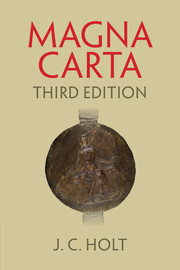Book contents
- Frontmatter
- Dedication
- Contents
- List of plates
- Preface to third edition
- Preface to second edition
- Preface to first edition
- Acknowledgements
- Abbreviations
- Introduction
- 1 The Charter and its history
- 2 Government and society in the twelfth century
- 3 Privilege and liberties
- 4 Custom and law
- 5 Justice and jurisdiction
- 6 Crisis and civil war
- 7 Quasi Pax
- 8 The quality of the Great Charter
- 9 The achievement of 1215
- 10 From distraint to war
- 11 The re-issues and the beginning of the myth
- Appendices
- References
- Index
- Plate section
5 - Justice and jurisdiction
Published online by Cambridge University Press: 05 July 2015
- Frontmatter
- Dedication
- Contents
- List of plates
- Preface to third edition
- Preface to second edition
- Preface to first edition
- Acknowledgements
- Abbreviations
- Introduction
- 1 The Charter and its history
- 2 Government and society in the twelfth century
- 3 Privilege and liberties
- 4 Custom and law
- 5 Justice and jurisdiction
- 6 Crisis and civil war
- 7 Quasi Pax
- 8 The quality of the Great Charter
- 9 The achievement of 1215
- 10 From distraint to war
- 11 The re-issues and the beginning of the myth
- Appendices
- References
- Index
- Plate section
Summary
These matters must now be set in a jurisdictional framework; for men wove their political theories from words first spun in legal contexts. It has long been recognized that the cry for justice in 1215 exhibited some very peculiar, apparently contradictory features. On the one hand the Charter demanded that royal justice should be more accessible and better administered. On the other, it forbade unlawful arrests and disseisin, the sale or delay of justice, and it promised restitution for unjust fines and amercements. Apparently men wanted more, but were not altogether pleased with what they had. This contrast is striking and is to be explained by another. The common law of the Angevins gave the undertenant the opportunities and protection of varied routine procedures. But it left the tenant-in-chief still exposed to the vagaries of the king's will. This is the clue to the judicial provisions of the Charter. By and large it approved of what the undertenant had enjoyed and condemned what the tenant-in-chief had suffered. Hence it sought to give the magnate a legal security like that enjoyed by the freeman. During the minority of Henry III this was largely achieved. The protection of the law moved up, not down, the social scale.
Within a surprisingly short space of time the procedures which took shape under Henry II and his sons became manifestly popular. It was not simply that, within a single life-span, they had come to provide generally accepted and readily accessible procedures. They also attracted a wider and wider social spread of litigants. Glanvill's sample writ of mort d'ancestor concerned, not a hide of land, but a mere virgate; it initiated what became the commonest of all possessory actions. The first Foot of Fine was filed in the Treasury on the order of the Justiciar, Hubert Walter, and to the benefit of his brother Theobald, on 16 July 1195.
- Type
- Chapter
- Information
- Magna Carta , pp. 124 - 173Publisher: Cambridge University PressPrint publication year: 2015



